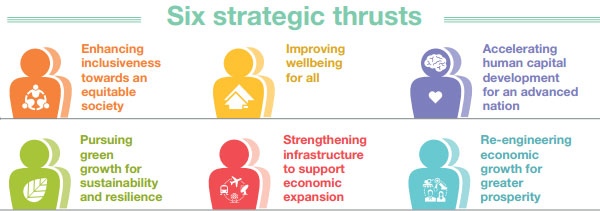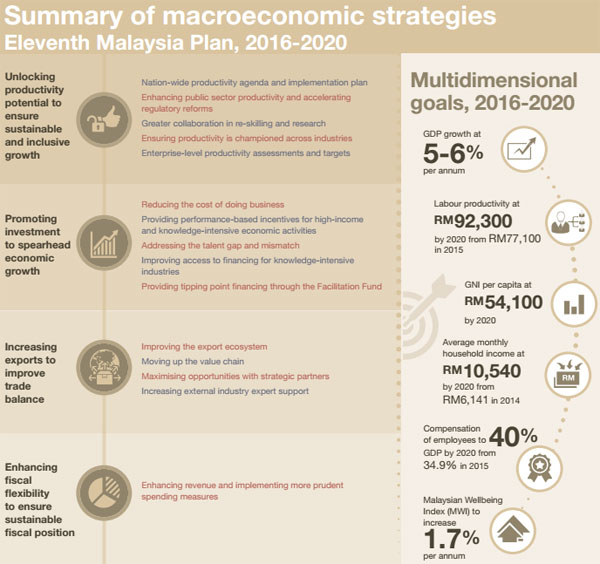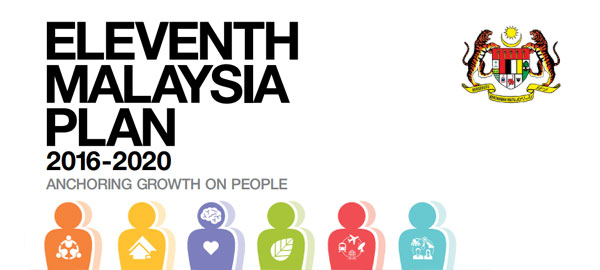The Malaysian government has released its eleventh economic development plan for the years 2016 to 2020. With ambitious economic objectives, the plan sets targets and defines some economic policies that will be implemented in the coming years, with the ultimate goal to make Malaysia a high income economy by 2020.
Malaysia to become an advanced economy by 2020
The eleventh economic plan for Malaysia identifies six “Strategic Thrusts”, key points along which the economic policies will focus to ensure Malaysia reaches its goal of becoming a high-income country by 2020. The key target for the whole plan is for Malaysia to reach the advanced economy status, that is to say a national income per capita above USD 15,000.

The Malaysian government also identified six “Game Changers”, innovative approaches that will change the trajectory for the country’s economic growth, enable it to reach its economic goals and help business in Malaysia.
- Unlocking the potential of productivity
- Uplifting the B40 households (bottom 40% household income group) towards a middle-class society
- Enabling industry-led Technical and Vocational Education and Training (TVET)
- Embarking on green growth
- Translating innovation to wealth
- Investing in competitive cities

Malaysia economic development plan 2016-2020 highlights
On May 21, 2015 Malaysian Prime Minister Najib Razak presented the economic plan for 2016-2020, here are the highlights of his speech reported by Reuters and Bernama:
Malaysian Prime Minister Najib Razak is confident that the Southeast Asia nation can achieve developed economy status by 2020 under an ambitious five-year economic development tabled in Parliament on Thursday.
The following are highlights of the five-year economic blueprint, which includes updated forecasts for the country’s economy and its finances as well as the introduction of new infrastructure projects.
Economic Outlook
- Real gross domestic product (GDP) is expected to expand between 5-6 percent per annum from 2016-2020, resulting in a 7.9 percent per annum rise in gross national income (GNI) per capita
- Malaysian economy to benefit from more robust global economic prospects, recovery of commodity prices and benign global inflation – Bernama
- Malaysia’s GDP to hit 2.6 trillion ringgit ($721.4 billion) in 2030
Inflation
Inflation to remain below 3 percent from 2016-2020
Investment
- Private investment expected to grow at an annual 9.4 percent between 2016-2020, estimated annual investment of 291 billion ringgit
- Public investment to grow at 2.7 percent per annum at an annual average of 131 billion ringgit
Exports
- Gross exports projected to see stronger growth at 4.6 percent per annum between 2016-2020
- Trade balance projected to remain positive with surplus of 57.3 billion ringgit by 2020
GNP
Gross national income per capita expected to reach $15,690 by 2020
Tax
Goods and services tax expected to bring in 31.4 billion ringgit revenue a year over next 5 years
Debt
Federal government total debt projected to drop below 45 percent by 2020
Oil
Dependence on oil-related revenue to decline to 15.5 percent by 2020
Workforce
More than 40 percent of total employment will comprise skilled workers
1 USD = 3.6040 Malaysian Ringgit on May 21, 2015
Complete economic development plan for Malaysia 2016-2020
The Malaysian government has produced a complete report on the economic orientations for the 2016-2020 economic plan. Together with data and results of the previous economic plans, it details the goals and future implementations of the various strategies.

Eleventh Malaysia Plan 2016-2020 – summary
The economic development plan for 2016-2020 is available to the general public. Here is the summary of the full document together with the link to download the full document.

Chapter 1 – Eleventh Malaysia Plan: Anchoring growth on people – page 17
- Anchoring growth on people 1-1
- In retrospect 1-3
- The next five years 1-6
- Challenges and opportunities 1-7
- Macroeconomic outlook 1-7
- Six strategic thrusts and six game changers 1-8
- Transforming public service for productivity 1-17
- Malaysia beyond 2020 1-17 Conclusion 1-18
Chapter 2 – Strengthening macroeconomic resilience for sustained growth – page 37
- Overview 2-1
- Highlights Tenth Malaysia Plan, 2011-2015: Achievements 2-3
- Looking back Tenth Malaysia Plan, 2011-2015: Progress 2-5
- External environment
- Domestic economy
- Issues and challenges
- Summary of macroeconomic strategies Eleventh Malaysia Plan, 2016-2020 2-11
- Macroeconomic prospects Eleventh Malaysia Plan, 2016-2020 2-13
- External environment
- Multidimensional goals
- Macroeconomic strategies to strengthen economic fundamentals
- Domestic economy
- Conclusion 2-24
Chapter 3 – Enhancing inclusiveness towards an equitable society – page 63
- Overview 3-1
- Highlights Tenth Malaysia Plan, 2011-2015: Achievements 3-3
- Looking back Tenth Malaysia Plan, 2011-2015: Progress 3-5
- Elevating the livelihood of the B40 households
- Building a progressive and more inclusive society
- Ensuring accessibility to basic infrastructure and services
- Promoting corridors as an engine of growth
- Enhancing Bumiputera economic participation
- Summary of focus areas Eleventh Malaysia Plan, 2016-2020 3-13
- Moving forward Eleventh Malaysia Plan, 2016-2020 3-15
- Focus area A Uplifting B40 households towards a middle-class society
- Focus area B Empowering communities for a productive and prosperous society
- Focus area C Transforming rural areas to uplift wellbeing of rural communities
- Focus area D Accelerating regional growth for better geographic balance
- Focus area E Enhancing Bumiputera Economic Community (BEC) opportunities to increase wealth ownership
- Conclusion 3-36
Chapter 4 – Improving wellbeing for all – page 101
- Overview 4-1
- Highlights Tenth Malaysia Plan, 2011-2015: Achievements 4-3
- Looking back Tenth Malaysia Plan, 2011-2015: Progress 4-5
- Improving access to quality healthcare services
- Ensuring access to quality and affordable housing
- Making streets and communities safer for rakyat peace of mind
- Enhancing social cohesion and national unity
- Promoting a sports culture and developing talent to enhance wellbeing
- Summary of focus areas Eleventh Malaysia Plan, 2016-2020 4-11
- Moving forward Eleventh Malaysia Plan, 2016-2020 4-13
- Focus area A Achieving universal access to quality healthcare
- Focus area B Providing adequate and quality affordable housing to poor, lowand middle-income households
- Focus area C Creating safer living environments for thriving communities
- Focus area D Improving road safety and emergency services to reduce fatalities
- Focus area E Enculturating the spirit of 1Malaysia to foster social cohesion and national unity
- Focus area F Promoting sports for healthy living and unity
- Conclusion 4-24
Chapter 5 – Accelerating human capital development for an advanced nation – page 127
- Overview 5-1
- Highlights Tenth Malaysia Plan, 2011-2015: Achievements 5-3
- Looking back Tenth Malaysia Plan, 2011-2015: Progress 5-5
- Creating more jobs and maintaining full employment
- Improving legislations and institutions to transform the labour market
- Mainstreaming and broadening access to quality TVET programmes
- Upskilling the workforce through lifelong learning
- Improving education delivery through better access and quality
- Summary of focus areas Eleventh Malaysia Plan, 2016-2020 5-13
- Moving forward Eleventh Malaysia Plan, 2016-2020 5-15
- Focus area A Improving labour market efficiency to accelerate economic growth
- Focus area B Transforming TVET to meet industry demand
- Focus area C Strengthening lifelong learning for skills enhancement
- Focus area D Improving the quality of education for better student outcomes and institutional excellence
- Conclusion 5-30
Chapter 6 – Pursuing green growth for sustainability and resilience – page 159
- Overview 6-1
- Highlights Tenth Malaysia Plan, 2011-2015: Achievements 6-3
- Looking back Tenth Malaysia Plan, 2011-2015: Progress 6-5
- Climate mitigation: reducing Malaysia’s carbon footprint
- Climate adaptation: protecting the nation from the impact of climate change
- Enhancing conservation of the nation’s ecological assets
- Summary of focus areas Eleventh Malaysia Plan, 2016-2020 6-9
- Moving forward Eleventh Malaysia Plan, 2016-2020 6-11
- Focus area A Strengthening the enabling environment for green growth
- Focus area B Adopting the sustainable consumption and production concept
- Focus area C Conserving natural resources for present and future generations
- Focus area D Strengthening resilience against climate change and natural disasters
- Conclusion 6-30
Chapter 7 – Strengthening infrastructure to support economic expansion – page 190
- Overview 7-1
- Highlights Tenth Malaysia Plan, 2011-2015: Achievements 7-3
- Looking back Tenth Malaysia Plan, 2011-2015: Progress 7-5
- Upgrading physical infrastructure to enhance access and connectivity
- Developing a people-centric public transport system
- Growing logistics and trade facilitation
- Increasing broadband coverage and initiating migration to Digital Terrestrial Television (DTT)
- Continuing efforts to restructure the water services industry
- Ensuring effective sourcing and delivery of energy
- Summary of focus areas Eleventh Malaysia Plan, 2016-2020 7-13
- Moving forward Eleventh Malaysia Plan, 2016-2020 7-15
- Focus area A Building an integrated need-based transport system
- Focus area B Unleashing growth of logistics and enhancing trade facilitation
- Focus area C Improving coverage, quality and affordability of digital infrastructure
- Focus area D Continuing the transition to a new water services industry framework
- Focus area E Encouraging sustainable energy use to support growth
- Conclusion 7-42
Chapter 8 – Re-engineering economic growth for greater prosperity – page 235
- Overview 8-1
- Highlights Tenth Malaysia Plan, 2011-2015: Achievements 8-3
- Looking back Tenth Malaysia Plan, 2011-2015: Progress 8-5
- Sector outcomes
- Liberalisation and regulatory reform
- Innovation
- Regional economic corridors development
- Summary of focus areas Eleventh Malaysia Plan, 2016-2020 8-13
- Moving forward Eleventh Malaysia Plan, 2016-2020 8-15
- Focus area A Transforming services
- Focus area B Energising manufacturing
- Focus area C Modernising agriculture
- Focus area D Transforming construction
- Focus area E Growing dynamic SMEs
- Focus area F Translating innovation to wealth
- Focus area G Investing in competitive cities and regional economic corridors
- Conclusion 8-40
Chapter 9 – Transforming public service for productivity – page 277
- Overview 9-1
- Highlights Tenth Malaysia Plan, 2011-2015: Achievements 9-3
- Looking Back Tenth Malaysia Plan, 2011-2015: Progress 9-5
- Summary of focus areas Eleventh Malaysia Plan, 2016-2020 9-9
- Moving forward Eleventh Malaysia Plan, 2016-2020 9-11
- Focus area A Enhancing service delivery with citizens at the centre
- Focus area B Rationalising public sector institutions for greater productivity and performance
- Focus area C Strengthening talent management for the public service of the future
- Focus area D Enhancing project management for better and faster outcomes
- Focus area E Capitalising on local authorities for quality services at the local level
- Conclusion 9-26
Chapter 10 – Malaysia beyond 2020 – page 305
- Overview 10-1
- Profile of Malaysia post-2020 10-3
- Aspirations for Malaysia post-2020 10-5
- People 10-7
- Economy 10-11
- Environment 10-12
- Conclusion 10-13
Appendices – page 320
- Tables and exhibits A-1
- Glossary A-19
- List of Strategy Papers A-26
- Description of cover icons A-27
- Index A-31
You can find more information on the Eleventh Malaysia Plan 2016-2020, details as well as the version in Bahasa Malaysia at the Eleventh Malaysia Plan 2016-2020 home page.




![Malaysia real estate overview [reports] Malaysia-real-estate](https://aseanup.com/wp-content/uploads/2016/07/Malaysia-real-estate-150x68.jpg)





Thanks for the authentic policy extracts. It was very useful for planning our activities for this year 2016.
useful report